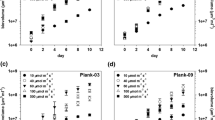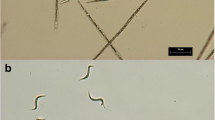Abstract
Atrazine is an herbicide frequently detected in watercourses that can affect the phytoplankton community, thus impacting the whole food chain. This study aims, firstly, to measure the sensitivity of monocultures of the green alga Scenedemus obliquus and toxic and non-toxic strains of the cyanobacteria Microcystis aeruginosa before, during and after a 30-day acclimation period to 0.1 µM of atrazine. Secondly, the sensitivity of S. obliquus and M. aeruginosa to atrazine in mixed cultures was evaluated. Finally, the ability of these strains to remove atrazine from the media was measured. We demonstrated that both strains of M. aeruginosa had higher growth rate-based EC50 values than S. obliquus when exposed to atrazine, even though their photosynthesis-based EC50 values were lower. After being exposed to 0.1 µM of atrazine for 1 month, only the photosynthesis-based EC50 of S. obliquus increased significantly. In mixed cultures, the growth rate of the non-toxic strain of M. aeruginosa was higher than S. obliquus at high concentrations of atrazine, resulting in a ratio of M. aeruginosa to total cell count of 0.6. This lower sensitivity might be related to the higher growth rate of cyanobacteria at low light intensity. Finally, a negligible fraction of atrazine was removed from the culture media by S. obliquus or M. aeruginosa over 6 days. These results bring new insights on the acclimation of some phytoplankton species to atrazine and its effect on the competition between S. obliquus and M. aeruginosa in mixed cultures.




Similar content being viewed by others
References
Alva-Martínez, AF, Sarma, SSS, Nandini, S, (2004) Population growth of Daphnia pulex (Cladocera) on a mixed diet (Microcystis aeruginosa with Chlorella or Scenedesmus). Crustaceana 77:973–988. http://www.jstor.org/stable/20105779
Bendall DS, Manasse RS (1995) Cyclic photophosphorylation and electron transport. Biochimica et Biophysica Acta Bioenergetics 1229:23–38. doi:10.1016/0005-2728(94)00195-B
Bérard A, Leboulanger S, Pelte T (1999) Tolerance of Oscillatoria limnetica Lemmermann to atrazine in natural phytoplankton populations and in pure culture: influence of season and temperature. Arch Environ Contam Toxicol 37:472–479. doi:10.1007/s002449900541
Campos MMC, Faria VHF, Teodoro TS, Barbosa FAR, Magalhães SMS (2013) Evaluation of the capacity of the cyanobacterium Microcystis novacekii to remove atrazine from a culture medium. J Environ Sci Health Part B 48:101–107. doi:10.1080/15226514.2010.52554910.1080/03601234.2013.726891
Caux P-Y, Kent RA (1995) Towards the development of site-specific water quality objective for atrazine in the Yamaska river, Quebec, for the protection of aquatic life. Water Qual Res J Can 30:157–178. doi:10.1016/j.aquatox.2012.09.005
Cepoi L, Dontu N, Salaru V, Salaru V (2016) Removal of organic pollutants from wastewater by cyanobacteria. In: Zinicovscaia I, Cepoi L (eds) Cyanobacteria for bioremediation of wastewaters. Springer International Publishing, pp 27–44
Chalifour A, Juneau P (2011) Temperature-dependent sensitivity of growth and photosynthesis of Scenedesmus obliquus, Navicula pelliculosa and two strains of Microcystis aeruginosa to the herbicide atrazine. Aquat Toxicol 103:9–17. doi:10.1016/j.aquatox.2011.01.016
Deblois CP, Dufresne K, Juneau P (2013) Response to variable light intensity in photoacclimated algae and cyanobacteria exposed to atrazine. Aquat Toxicol 126:77–84. doi:10.1016/j.aquatox.2012.09.005
Deblois CP, Juneau P (2012) Comparison of resistance to light stress in toxic and non-toxic strains of Microcystis aeruginosa (Cyanophyta). J Phycol 48:1002–1011. doi:10.1111/j.1529-8817.2012.01191.x
Devilla RA, Brown MT, Donkin M, Readman JW (2005) The effects of a PSII inhibitor on phytoplankton community structure as assessed by HPLC pigment analyses, microscopy and flow cytometry. Aquat Toxicol 71:25–38. doi:10.1016/j.aquatox.2004.10.002
Dosnon-Olette R, Couderchet M, Oturan MA, Oturan N, Eullaffroy P (2011) Potential use of Lemna minor for the phytoremediation of isoproturon and glyphosate. Int J Phytoremediation 13:601–612. doi:10.1080/15226514.2010.525549
Fedtke C, Duke SO (2004) Herbicides. In: Hock B, Elstner EF (eds) Plant toxicology, 4th edn, CRC Press, New York, pp 247–330
García-Villada L, Reboud X (2007) Induction of atrazine tolerance in a natural soil assemblage of microalgae reared in the laboratory. Ecotoxicol Environ Saf 66:102–106. doi:10.1016/j.ecoenv.2005.09.003
Giroux I (2015) Présence de pesticides dans l’eau au Québec: portrait et tendances dans les zones de maïs et de soya—2011 à 2014, ISBN 978-2-550-73603-5, Québec, 47 pp and 43 annexes
González R, García-Balboa C, Rouco M, Lopez-Rodas V, Costas E (2012) Adaptation of microalgae to lindane: a new approach for bioremediation. Aquat Toxicol 109:25–32. doi:10.1016/j.aquatox.2011.11.015
González-Barreiro O, Rioboo C, Herrero C, Cid A (2006) Removal of triazine herbicides from freshwater systems using photosynthetic microorganisms. Environ Pollut 144:266–271. doi:10.1016/j.envpol.2005.12.014
Graymore M, Stagnitti F, Allinson G (2001) Impacts of atrazine in aquatic ecosystems. Environ Int 26:483–495. doi:10.1016/S0160-4120(01)00031-9
Huertas IE, Rouco M, López-Rodas V, Costas E (2010) Estimating the capability of different phytoplankton groups to adapt to contamination: herbicides will affect phytoplankton species differently. New Phytol 188:478–487. doi:10.1111/j.1469-8137.2010.03370.x
Jakob T, Schreiber U, Kirchesch V, Langner U, Wilhelm C (2005) Estimation of chlorophyll content and daily primary production of the major algal groups by means of multiwavelength-excitation PAM chlorophyll fluorometry: performance and methodological limits. Photosynth Res 83:343–361. doi:10.1007/s11120-005-1329-2
Kasai F (1999) Shifts in herbicide tolerance in paddy field periphyton following herbicide application. Chemosphere 38:919–931. doi:10.1016/S0045-6535(98)00221-5
Lockert CK, Hoagland KD, Siegfried BD (2006) Comparative sensitivity of freshwater algae to atrazine. Bull Environ Contam Toxicol 76:73–79. doi:10.1007/s00128-005-0891-9
Lürling M, Roessink I (2006) On the way to cyanobacterial blooms: impact of the herbicide metribuzin on the competition between a green alga (Scenedesmus) and a cyanobacterium (Microcystis). Chemosphere 65:618–626. doi:10.1016/j.chemosphere.2006.01.073
Marvá F, López-Rodas V, Rouco M, Navarro M, Toro FJ, Costas E, Flores-Moya A (2010) Adaptation of green microalgae to the herbicides simazine and diquat as result of pre-selective mutations. Aquat Toxicol 96:130–134. doi:10.1016/j.aquatox.2009.10.009
Murdock JN, Shields Jr FD, Lizotte Jr RE (2013) Periphyton responses to nutrient and atrazine mixtures introduced through agricultural runoff. Ecotoxicology 22:215–230. doi:10.1007/s10646-012-1018-9
Nelson KJ, Hoagland KD, Siegfried BD (1999) Chronic effects of atrazine on tolerance of a benthic diatom. Environ Toxicol Chem 18:1038–1045. http://digitalcommons.unl.edu/entomologyfacpub/54
Pannard A, Le Rouzic B, Binet F (2009) Response of phytoplankton community to low-dose atrazine exposure combined with phosphorus fluctuations. Arch Environ Contam Toxicol 57:50–59. doi:10.1007/s00244-008-9245-z
Peltier G, Tolleter D, Billon E, Cournac L (2010) Auxiliary electron transport pathways in chloroplasts of microalgae. Photosynth Res 106:19–31. doi:10.1007/s11120-010-9575-3
Pennington PL, Scott GI (2001) Toxicity of atrazine to the estuarine phytoplankter Pavlova sp. (Prymnesiophyceae): Increased sensitivity after long-term, low-level population exposure. Environ Toxicol Chem 20:2237–2242. doi:10.1002/etc.5620201016
Plumley FG, Davis D (1980) The effects of a photosynthesis inhibitor atrazine, on salt marsh edaphic algae, in culture, microecosystems, and in the field. Estuaries Coasts 3:271–277. doi:10.2307/1352082
Qian H, Tsuji T, Endo T, Sato F (2014) PGR5 and NDH pathways in photosynthetic cyclic electron transfer respond differently to sublethal treatment with photosystem-interfering herbicides. J Agric Food Chem 62:4083–4089. doi:10.1021/jf500143f
Sajjaphan K, Shapir N, Judd AK, Wackett LP, Sadowsky MJ (2002) Novel psbA1 gene from a naturally occurring atrazine-resistant cyanobacterial isolate. Appl Environ Microbiol 68:1358–1366. doi:10.1128/aem.68.3.1358-1366.2002
Schmitt-Jansen M, Altenburger R (2005a) Predicting and observing responses of algal communities to photosystem II-herbicide exposure using pollution-induced community tolerance and species-sensitivity distributions. Environ Toxicol Chem 24:304–312. doi:10.1897/03-647.1
Schmitt-Jansen M, Altenburger R (2005b) Toxic effects of isoproturon on periphyton communities - a microcosm study. Estuarine Coast Shelf Sci 62:539–545. doi:10.1016/j.ecss.2004.09.016
Schmitt-Jansen M, Altenburger R (2008) Community-level microalgal toxicity assessment by multiwavelength-excitation PAM fluorometry. Aquat Toxicol 86:49–58. doi:10.1016/j.aquatox.2007.10.001
Seguin F, Le Bihan F, Leboulanger C, Bérard A (2002) A risk assessment of pollution: induction of atrazine tolerance in phytoplankton communities in freshwater outdoor mesocosms, using chlorophyll fluorescence as an endpoint. Water Res 36:3227–3236. doi:10.1016/S0043-1354(02)00013-1
Stange K, Swackhamer DL (1994) Factors affecting phytoplankton species-specific differences in accumulation of 40 polychlorinated biphenyls (PCBs). Environ Toxicol Chem 13:1849–1860. doi:10.1002/etc.5620131117
Stein JR (1973) Culture methods and growth measurements. Cambridge University Press, Cambridge
Strasser RJ, Srivastava A, Tsimilli-Michael M (2000) The fluorescence transient as a tool to characterize and screen photosynthetic samples. In: Yunus M, Pathre U, Mohanty P (eds) Probing photosynthesis: mechanisms, regulation and adaptation. Taylor & Francis, London, pp 443–480
Sullivan DJ, Vecchia AV, Lorenz DL, Gilliom RJ, Martin JD (2009) Trends in pesticide concentrations in corn-belt streams, 1996–2006: U.S. Geological Survey Scientific Investigations Report 2009-5132, 75 pp
Tang J, Hoagland KD, Siegfried BD (1998) Uptake and bioconcentration of atrazine by selected freshwater algae. Environ Toxicol Chem 17:1085–1090. doi:10.1897/1551-5028(1998)017%3C1085:UABOAB%3E2.3.CO;2
Tuckey DM, Orcutt DM, Hipkins PLL (2002) Inherent and growth stage-related differences in growth and lipid and sterol composition of algal species sensitive and tolerant to sterol-inhibiting fungicides. Environ Toxicol Chem 21:1715–1723. doi:10.1002/etc.5620210825
Vermaas WF (2001) Photosynthesis and respiration in cyanobacteria. Encycl Life Sci 1–7. doi:10.1038/npg.els.0001670
Wang S, Zhang D, Pan X (2013) Effects of cadmium on the activities of photosystems of Chlorella pyrenoidosa and the protective role of cyclic electron flow. Chemosphere 93:230–237. doi:10.1016/j.chemosphere.2013.04.070
Weiner JA, DeLorenzo ME, Fulton MH (2004) Relationship between uptake capacity and differential toxicity of the herbicide atrazine in selected microalgal species. Aquat Toxicol 68:121–128. doi:10.1016/j.aquatox.2004.03.004
Weyman GS, Rufli H, Weltje L, Salinas ER, Hamitou M (2012) Aquatic toxicity tests with substances that are poorly soluble in water and consequences for environmental risk assessment. Environ Toxicol Chem 31:1662–1669. doi:10.1002/etc.1856
You L, He L, Tang YJ (2015) Photoheterotrophic fluxome in Synechocystis sp. strain PCC 6803 and its implications for cyanobacterial bioenergetics. J Bacteriol 197:943–950. doi:10.1128/jb.02149-14
Zablotowicz RM, Schrader KK, Locke MA (1998) Algal transformation of fluometuron and atrazine by N-dealkylation. J Environ Sci Health Part B 33:511–528. doi:10.1080/03601239809373160
Acknowledgments
The authors would like to thank Stéphanie Potvin and Denis Flipo for her technical assistance in this project.
Funding
Financial support was provided by the Natural Sciences and Engineering Research Council of Canada (NSERC, grant #262210–2011) awarded to PJ. AC received an Alexander-Graham-Bell scholarship from NSERC.
Author information
Authors and Affiliations
Corresponding author
Ethics declarations
Conflict of interest
The authors declare that they have no conflict of interests.
Ethical approval
This article does not contain any studies with human participants or animals performed by any of the authors.
Rights and permissions
About this article
Cite this article
Chalifour, A., LeBlanc, A., Sleno, L. et al. Sensitivity of Scenedesmus obliquus and Microcystis aeruginosa to atrazine: effects of acclimation and mixed cultures, and their removal ability. Ecotoxicology 25, 1822–1831 (2016). https://doi.org/10.1007/s10646-016-1728-5
Accepted:
Published:
Issue Date:
DOI: https://doi.org/10.1007/s10646-016-1728-5




